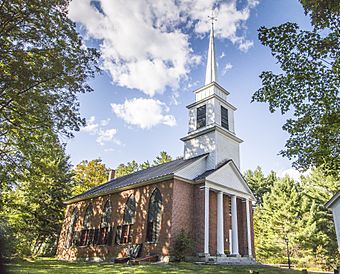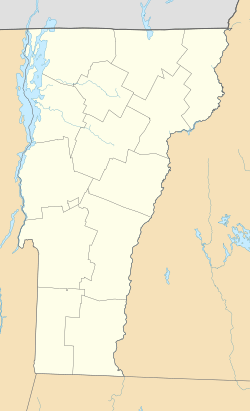Grafton Congregational Church and Chapel facts for kids
|
Grafton Congregational Church and Chapel
|
|
|
U.S. Historic district
Contributing property |
|
 |
|
| Location | Main St., Grafton, Vermont |
|---|---|
| Area | 1 acre (0.40 ha) |
| Built | 1833 |
| Architectural style | Greek Revival, Gothic Revival |
| Part of | Grafton Village Historic District (ID10000171) |
| NRHP reference No. | 79000230 |
Quick facts for kids Significant dates |
|
| Added to NRHP | December 10, 1979 |
| Designated CP | April 7, 2010 |
The Grafton Congregational Church is a very old and important building in Grafton, Vermont. People often call it The Brick Church because of how it looks. It was built a long time ago, in 1833. This church shows off two cool styles of building: Greek Revival and Gothic Revival. It's so special that it was added to the National Register of Historic Places in 1979. Today, the church group that used to meet here now uses a different building nearby.
What Makes the Church Special?
The Grafton Congregational Church is on the west side of Grafton village. It sits where Main Street meets Hinkley Brook and Middletown Roads. This building has two stories and is made of brick. The bricks are laid in a special pattern.
The church has a sloped roof. At the front, there's a part that sticks out with a pointed roof. This part is held up by columns and flat pillars. The bottom parts of these supports are made from soapstone.
The windows on the sides of the church have pointed tops. These tops are called lancet arches. A tall, square tower rises above the main entrance. This tower has three sections. On top of the tower is an eight-sided spire with flat panels.
How the Church Was Built
The church was built in 1833 for Grafton's first church group. This group started way back in 1785. The building was officially opened in 1834.
Later, between 1859 and 1862, the church became bigger. More people joined the church group, so they needed more space. This is likely when the Gothic-style parts were added to the building.
Even though fewer people lived in the town, the church group kept growing. They added a smaller building, called a chapel, sometime between 1867 and 1883. This chapel stands in front of the main church building.
In 1920, the church group joined with the local Baptists. They did this to save money and work together. As of 1979, when the church was added to the National Register, both groups still shared the two buildings.
See Also



